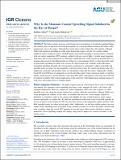Why Is the Monsoon Coastal Upwelling Signal Subdued in the Bay of Bengal?
Author(s)
Abbott, Kathleen; Mahadevan, Amala
DownloadJGR Oceans - 2024 - Abbott - Why Is the Monsoon Coastal Upwelling Signal Subdued in the Bay of Bengal.pdf (3.323Mb)
Publisher with Creative Commons License
Publisher with Creative Commons License
Creative Commons Attribution
Terms of use
Metadata
Show full item recordAbstract
The Indian summer monsoon, which brings heavy precipitation to the densely populated Indiansubcontinent, plays an important role in the development of a coastal upwelling circulation that brings colder,nutrient‐rich water to the surface. Although the western shores of the Arabian Sea (AS) and Bay of Bengal(BoB) both experience upwelling‐favorable winds during June‐August, only the AS coastline exhibitssignificant surface cooling. In contrast, the BoB remains warm and its upwelling is characterized by a transient,weak sea surface temperature (SST) response confined to the east coast of India. A weaker mean alongshorewind stress and coastal circulation do not sufficiently explain the lack of SST response in the BoB. Here, weexamine other reasons for the differing behavior of these two coastal margins. Firstly, we show that while windsare persistently upwelling‐favorable in the western AS, intraseasonal wind variability in the BoB inducesintermittent upwelling. Secondly, the vertical density stratification is controlled by salinity in the BoB, andupwelled waters are saltier, but only marginally cooler than surface waters. By contrast, the density in the AS istemperature‐controlled, and upwelled waters are substantially colder than the surface. Additionally, satellite‐based SST in the BoB does not adequately resolve the upwelling signal. Using a numerical model, we find thatsalinity stratification has a greater influence on the mean SST, while wind frequency alters near‐shore SST andits temporal variability. This work has implications for the sensitivity of upwelling regions and their response towind stress and stratification in a warming climate.
Date issued
2024-12-10Department
Joint Program in Oceanography/Applied Ocean Science and Engineering; Woods Hole Oceanographic InstitutionJournal
Journal of Geophysical Research: Oceans
Publisher
American Geophysical Union (AGU)
Citation
Abbott, K., & Mahadevan, A. (2024). Why is the monsoon coastal upwelling signal subdued in the Bay of Bengal? Journal of Geophysical Research: Oceans, 129, e2024JC022023.
Version: Final published version
ISSN
2169-9275
2169-9291